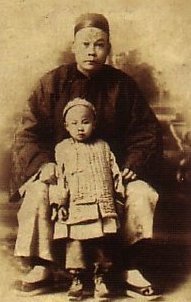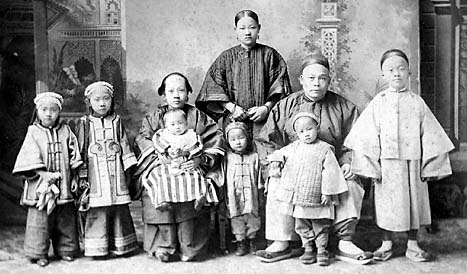
The Wong Family of Deadwood (1896).
From the Deadwood Adams Memorial Hall Museum
Maid, Shu Lin Lau, standing. Wong family from left to right - daughter King Que, daughter King Shiu, mother Hal Shek holding daughter Fay Juck, daughter Fay King, father Fee Lee with son Som Quong and son Hong Quong. Not in photo are the youngest son, Tong Quong and the youngest daughter, Wai Lan.
I often
wonder about my roots. I could not find
much on my mother's side but I had better luck on my father's side. I had
never met my paternal grandparents and I didn't know much about them until 1966
when my father took us to Deadwood,
.
We visited the Deadwood Adams Memorial Hall Museum in 1966. From left to right, my brother George, Dad, Mom, wife Nancy and I carrying our son, Ulysses. My father was pointing at a photo of his parents and siblings, my grandparents, uncles and aunts.
When I first decided to create this web page, I asked cousin Kam Leung, son of uncle Som Quong for advice. Cousin Kam Leung had done extensive research on grandfather's background; he knew grandfather Fee Lee Wong better than anyone in the family. With his advice and guidance, I am able to create this web page.
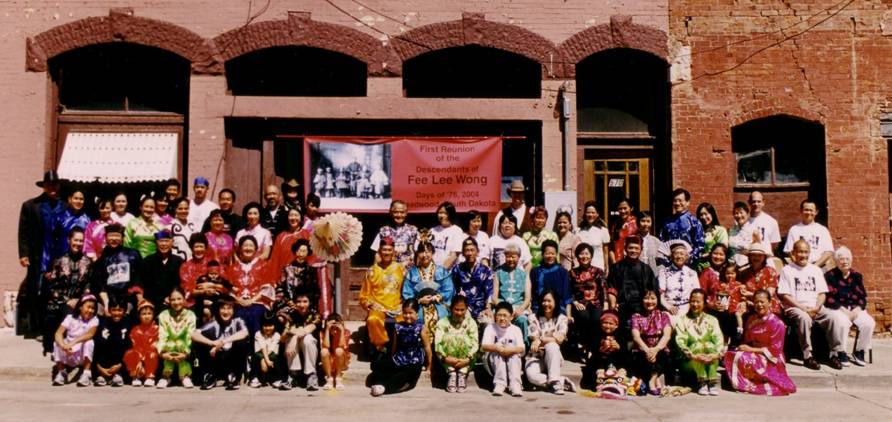
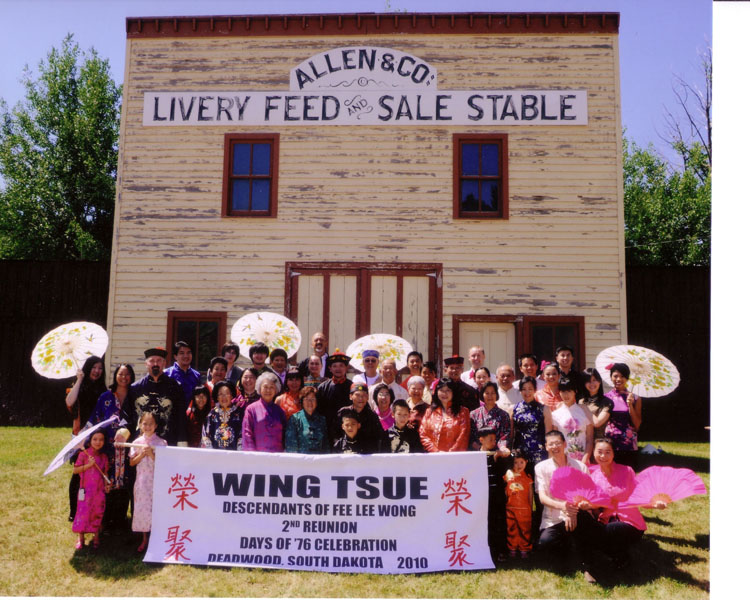
Here is an article published by The Northern Hills Journal (Rapid City, South Dakota) in August 11, 2004 on the reunion as well as a brief background of Fee Lee Wong’s role as a pioneer in Deadwood.
Deadwood’s Chinese History Draws Pioneer Family to Black Hills.
The ”First Chinese Family of Deadwood” made a triumphant return to the Black Hills last month and got a glimpse of their history as Americans. Descendants of Fee Lee Wong, owner of the Deadwood Wing Tsue Emporium from the 1880 to 1910s, gathered for their first ever family reunion July 25-31. Family members came to Deadwood from across the United States, but the majority hailed from the San Francisco Bay area. The 67 family members who came to Deadwood are believed by local historians to be the largest gathering of Chinese Americans in Deadwood since the 1980s. “The people came here to see their roots,” family member Bill Wong of San Francisco said. “Deadwood has changed a lot, but it is exciting.” Reunion organizer Edith Wong, Fee Lee’s great granddaughter, said family members like to organize another reunion in five years or so. Everyone expressed excitement toward another reunion,” she said. “People learned enough about the history and had enough enthusiasm to definitely come back.” Edith Wong said the family was greeted with a warm hospitality that makes them want to return to Deadwood. Wong herself has traveled to Deadwood four times from her home in San Luis Obispo, California. “You have an openness and friendliness and interest in history,” she said of the Deadwood area. “There was a lot of support of reunion, and we got a lot of help. Everyone helps without question, and there’s a lot of appreciation of history.” Family members in attendance ranged in age from 80 all the way down to 6 months old. Wong said the reunion maintained a busy schedule but also had the goal of passing its own roots on to younger generations.
U. S. Family History Dates to 1870s
The Chinese community played an intricate part in the development of Deadwood. An estimated 200 to 400 Chinese immigrants began arriving in Deadwood shortly after the gold rush in 1876. Deadwood’s Chinatown, in an area once called the “Badlands” for its brothels and rowdy saloons, were quickly set up at the lower end of Main Street. In the community, Chinese were able to practice their culture, including traditional funeral services and elaborate New Year’s celebrations that are still commemorated. Like other prospectors, the Chinese came to seek fortunes in gold but discovered that the service industry was more lucrative. Although some were miners, most found employment in laundries and restaurants or as house servants.
Fee Lee Wong
Historians refer to the Wongs as Deadwood’s “First Family” because Fee Lee Wong’s wife and children were prominent and successful pioneers in the city. Fee Lee Wong was born in Southern China in 1846 and heard the stories of gold rushes in the United States. He traveled by boat to the United States in 1870, leaving his wife behind in China. Family members surmise that Wong worked as a cook for railroad crews in California. Workers such as Wong gravitated toward running a laundry because, according to family members, southern Chinese customarily bathe and wash clothes every day.
Eventually, Wong hooked up with a group of miners that was headed to the Black Hills in the late 1870s, an era when Chinese people were considered outsiders and inferior to Caucasians. The prospectors fought off bandits and other hardship en route to the Hills. The miners and Wong must have formed a tight bond because the prospectors included Wong in their distribution of mining claims. Fee Lee Wong received title to two or three mining claims, setting in motion a string of good fortune and clever business decisions that vaulted Wong into prominence in Deadwood history.
A claim next to Wong’s produced gold making Wong’s claim more valuable. Wong sold his claim for an unknown price, but he made enough money to start a business in 1882 at 566 Main St. – the Wing Tsue Company. Wing Tsue has been translated from the Cantonese dialect to mean “Assembly of Glories”. Newspapers accounts from the 1880s called Wong “Wing Tsue” after the name of his business, and his family members were also called Wing Tsue. One advertisement lists some of Wing Tsue’s inventory of ornamental chinaware, toiletries and perfume, embroidered banners, silk shawls, handkerchiefs and imported teas. Wong was also given the moniker Dr. Wing Tsue because he carried a variety of herbal medicines in his store.
He returned to China in 1882 and learned that his wife had died. He stayed in China for two years and remarried. He brought his new wife with him to Deadwood’s Chinatown, where the couple would raise eight children. In 1896, Wong built a brick building at 566 Main Street. Wong took his family back to China in 1902 in hopes they would learn the Chinese language and culture. He and his wife and youngest daughter returned to America and Deadwood in 1904. Other children return to America later. In 1919, he suffered a stroke at a Society of Black Hills Pioneers meeting. He returned to China where he died in 1921.
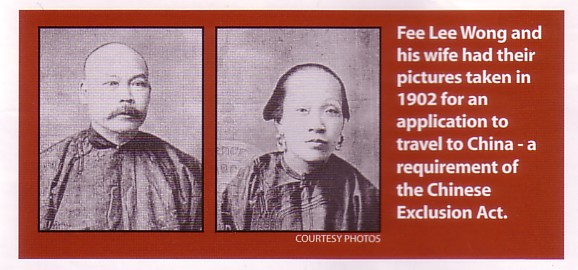 Grandfather Fee Lee & Grandmother Hal Shek
|
|
Fee Lee and son Som Quong |
The children went on to various endeavors in the United States and China. Hong Quong Wong, the oldest son attended the School of Mines in Rapid City and later worked at the Deadwood Post Office and the U. S. Immigration Service in El Paso, Texas. Som Quong Wong, the number two son was Deadwood High School freshman class president and earned an architecture engineering degree at the University of Michigan. He served as a Marine Corps captain in World War II. Tong Quong Wong, the youngest son learned to do magic tricks and performed in the United States and Asia. Daughter King Que married a Chinese merchant and lived in China until the 1950s. The rest of the children were married and remained in China.
Deadwood Chinatown
Fee Lee’s grandson, Kam Wong, sparked the family interest in Deadwood in the 1990s. Before his death in 2000, Kam was instrumental in establishing membership in the Society of Black Hills Pioneers and a scholarship fund that gives $2000 to four local high school each year. Kam’s widow, Beatrice Wong, help pay to have the society’s second family history book published. The book published earlier this summer, includes the Wong family story. Beatrice first saw Deadwood in 1955 and appreciated the small-town atmosphere then. She said the town looks entirely differently now. “But the (friendly) attitude is still the same.” The family members spent about a year planning their reunion. While in Deadwood, they heard a historical talk by Deadwood historic preservation director Jim Wilson, gleaned information on the Chinese Archaeological Dig from state archaeologist Rose Fosha, visited the original Wing Tsue building and participated in the Days of the ’76 parade. The descendants gathered in front of the building July 30 for a group photo (see above) before the parade. The Wong Family also asked the Deadwood Historic Preservation Commission to preserve the Wing Tsue building. On behalf of her family, Edith Wong addressed the commission at its July 28 meeting.
“Although Deadwood’s Chinese community is evident in publications, pamphlets, web sites and displays of archaeological excavation of artifacts. I feel that these do not compare to the significance and impact of an actual physical site.” Wong said. “I am requesting that the Historic Preservation Commission do what is in their authority and their financial means and in cooperation with the current owners to preserve what structurally remains of Deadwood’s historic Chinatown,” Wong said. “I feel that putting ‘Chinatown on the map” has potential for positive outcomes for the current owners, historic preservation, as well as for Deadwood tourism.”
Gene Johner, owner of Deadwood Gulch Saloon, owns the Wing Tsue building. Wilson said the building has been changed since the Chinese left Deadwood. “It is not what it was,” Wilson said. “It has been a lumberyard and an electrical supply store; that’s why there are those big doors on the front.” Fosha said work is under way to investigate the hillside behind the Wing Tsue building. Fosha said photographs and city maps indicate the Wong family not only lived in the building, they also used the hillside behind the building for their garden and additional living quarters. Fosha said she expects to find significant data on that hillside. Archaeologists are scheduled to start digging this week.
